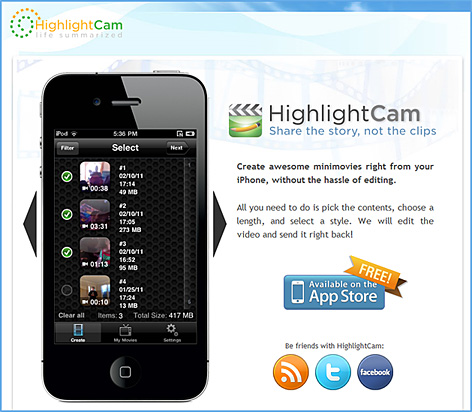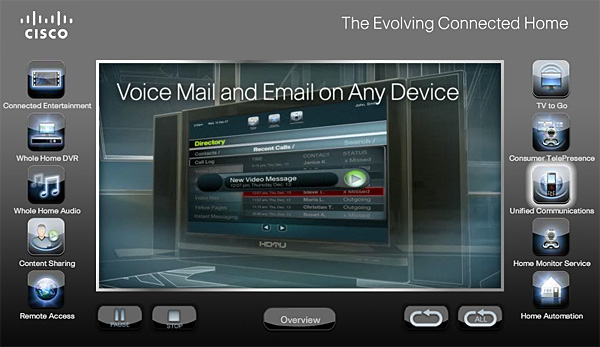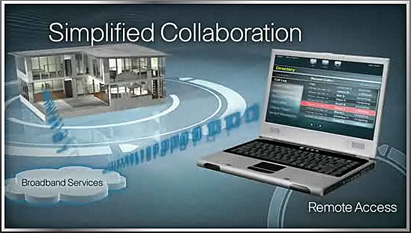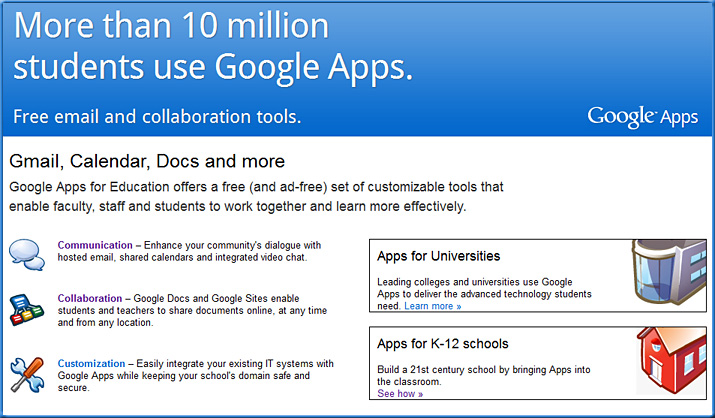Meet the winners of DEMO 2011 — from readwriteweb.com by Mike Melanson
Evidence of learning online: Assessment beyond the paper — from CampusTechnology.com by Judith Boettcher
…learning designer Judith Boettcher examines online assessment strategies beyond the traditional end-of-term paper.
Excerpts:
Professional Work Products
- Written and audio communications of all types, such as press announcements, white papers, briefs, summaries, memos, project management documentation
- Creating and planning news events, such as announcements, interviews, or regular updates of interests, such as podcasts
- Setting up personal or group blogs within different contexts of leadership, business, etc.
- Setting up wikis for team projects, areas for monitoring developments
- Many more listed…
Interviews
The interview medium is a very flexible communication tool and can be used by both faculty and students for demonstrating understanding and eliciting the state of concept development. Here are some possible strategies that can require research, critical thinking, and writing.
- Learners identify an expert or a person of interest to them in a particular field germane to the course and then prepare the interview questions, do the interview, and then post the results
- Learners identify and interview the author of a textbook or article closely related to the course, possibly updating information critical to the course
- Many more listed…
Audio, Video, and Visual Projects
What about other media such as audio and video projects? Today’s learners live surrounded by audio and video and the tools that make it possible for everyone to create and produce audio and video products. Here are some of the possibilities with audio and video spaces.
- Podcasting resources now are very common so learners are familiar enough with the format to embrace creating audio and video podcasts of their own
- Video shorts and ad hoc documentaries engage learners and draw in their friends and families
- Creating and posting short reports via VoiceThread is another “writing space” to consider as are Flickr, YouTube, and Slideshare
Blogs
Blogs are a very underutilized writing space. Blogs share many characteristics with journals and thus can capture snapshots of what learners are thinking, and when; plus they often can also capture the sources of some of their thinking. Blogs help learners understand the growth cycle of learning new concepts and how and why they think the way they do. Here are some ideas on how blogs, both personal and class, might be used.
- Personal commentary and self-reflection
- Capturing thought processes and generating new ideas
- Assist learners in finding their “voice”
- Many more…
Wikis
- Collaborating on group and team projects of all kinds
- Capturing and developing ideas for solving critical problems and case studies and simulations
- Developing “featured” Bronze star Wikipedia articles on specific topics in particular disciplines
Moodle 2.0 integrations – Alfresco — from Synergy Learning by Joel Kerr
As Moodle 2.0 becomes more established we are finding more and more clients eager to upgrade from their current version.
Not only is the software being recognised for it’s new and improved features, it also makes integrating with third party tools a whole lot easier, opening up a whole new world of possibilities for those moving to Moodle 2.0.
Over the next few blog posts I am going to look at some of these external tools to see what benefits they can bring to your operations….starting with Alfresco.
Alfresco
If you haven’t heard of Alfresco before you might find it a rather useful tool. It is a Content Management System (CMS), which basically means it can be used for managing the production of electronic content (text files, videos, graphics etc.) via a set of rules, processes and workflows.
Like Moodle and Mahara, Alfresco is Open Source and as a CMS it specializes in:
Google’s Gadfly — from InsideHigherEd.com
“Uncomfortably familial.” That is how Siva Vaidhyanathan, a professor of media studies at the University of Virginia, describes the relationship between higher education and Google — a company that has, in a little more than a decade, evolved from pet project of Stanford doctoral students to chief usher of the information age.
…
But as is often the case with cousins, the genetic differences between higher education and Google are more striking than their similarities. Beneath the interdependence and shared hereditary traits, tensions creep. And like an awkward Thanksgiving dinner, Vaidhyanathan’s new book, The Googlization of Everything (And Why We Should Worry) (University of California Press), provokes these tensions to the surface.
The Virginia professor, who is not afraid to confess his affection for the ease and usefulness of Google, nevertheless distrusts the company’s basic motivations as it vies for our intellectual inheritance. “Google has fostered a more seamless, democratized, global, cosmopolitan information ecosystem,” he writes. “Yet it has simultaneously contributed to the steady commercialization of higher education and the erosion of standards of information quality.”
Cool Tools – Rapid e-Learning with Brainshark or Captivate — from Blackboard’s Next Level Learning blog
Let’s say your company has a new product update and you need to get the information out fast to your team of sales and product managers. Or maybe your company is growing quickly and you need to train a brand new team in a matter of days. Did a new certification just get released and you need to get information out to your association members ASAP? No problem! This is where Blackboard and rapid e-learning tools like Brainshark and Captivate come in.
Also see:
- Brainshark Mobile & QR Tags: An Exciting Combination
QR Codes 101:
A QR (“quick response”) Code or Tag is a square barcode that you can scan with your smartphone’s camera with the help of a QR Code app to immediately launch a link or URL on the mobile phone’s web browser. Said another way, QR Codes are a simple way to connect the offline world with the online world. This represents a huge new point of delivery for Brainshark video presentations. Why is this important? …Because you want your content available when and where your audience is primed for it.
Embedplus.com — resource and quote below from Shola ‘Tay’ Omojokun, Co-founder, EmbedPlus.com
EmbedPlus can allow users to seamlessly and freely upgrade the videos they embed with attractive features that the standard YouTube player does not currently offer. It was recently mentioned to me that supported features like annotations and scene editing would be useful for teachers wanting to mark up lecture, demo, and videos posted on wikis, blogs, etc. Slow motion and zoom can have some useful applications for art, nature, and science videos.
.
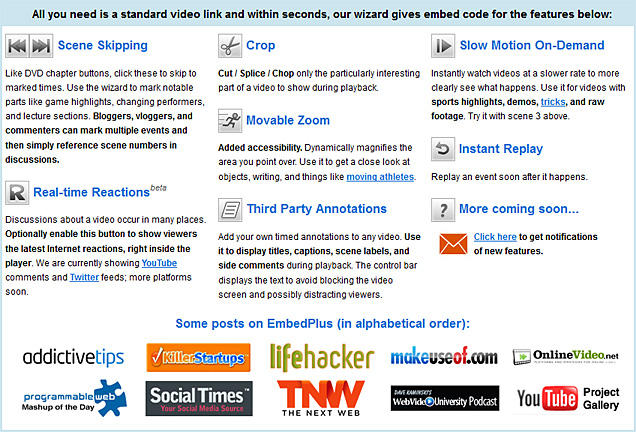
EmbedPlus as an educational tool for videos
.
From DSC:
With the increase of digital video, digital storytelling, lecture capture, and other related educational technologies, this tool may be helpful to you. Thanks Tay for the resource.
Addendum on 2-18-11 — also see:
- YouTube Lets You Change the Video Playback Speed — from Digital Inspiration by Amit Agarwal
Egyptian president steps down amidst groundbreaking digital revolution — from CNN.com
From DSC:
Though there may have been other factors involved here, various technologies played a significant role in Egypt — such as Twitter, Facebook and mobile phones.
Blackboard vs Moodle 2.0: 100+ metrics compared head to head — from MoodleNews.com by Joseph Thibault
This post is cross-posted at LMSWatch.com (comprehensive news and resources for all Learning Management Systems)
Ralf Otto of Ruhr-Universität, Bochum in Germany provided me with a wonderful resource he’s created recently. Ruhr-Universität utilizes both Moodle and Blackboard (as a growing number of colleges and higher education institutions are doing) and over the last two weeks was charged with comparing the two LMSs head to head, he said in his message.
The comparison matrix covers 103 different aspects of the LMS and whether or not each is capable (and sometimes how). How does each measure up?
…
For the full comparison that Ralf created please visit:
http://moodle.ruhr-uni-bochum.de/file.php/1/Feature_Comparison_Moodle-Blackboard.pdf
Jane Hart updates her Learning Tools Directory for 2011
- Instructional Tools
- Social & Collaboration Spaces
- Conferencing Tools
- Document and Presentation Tools
- Blogging, Web, and Wiki Tools
- Image, Audio, and Video Tools
- Communication Tools
- Microsharing Tools & Twitter Apps
- Personal Producitivity Tools
- Browers, Players, and Readers
Learn advanced uses of forms in Google Docs — from Free Technology for Teachers









